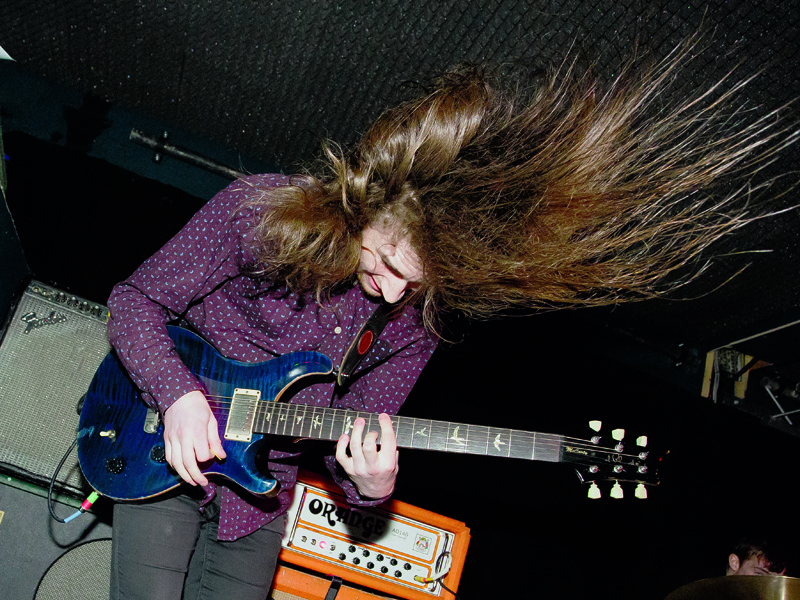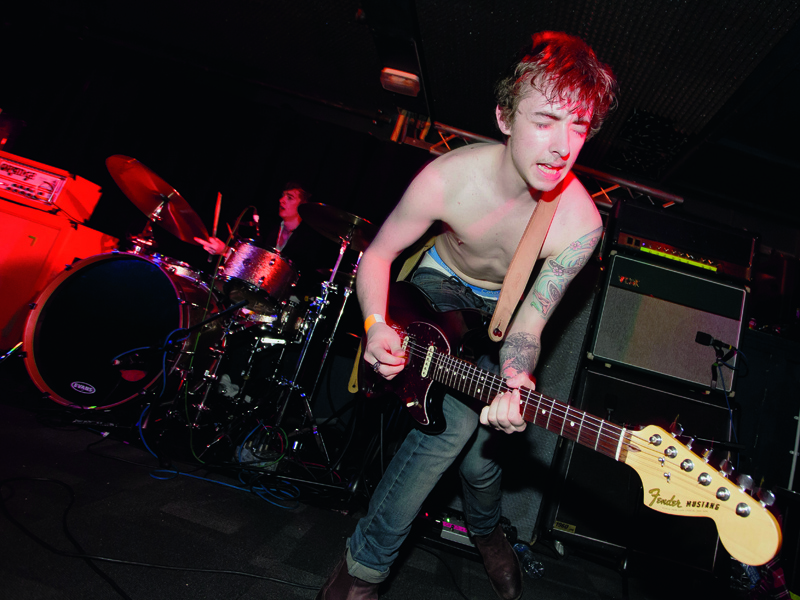Marmozets' guitarists on inspirations, live energy, rigs and more
Sam MacIntyre and Jack Bottomley take stock

Marmozets' Sam MacIntyre and Jack Bottomley take stock ahead of their major label debut
Some bands just seem to be guided by destiny. Marmozets’ guitarists Sam MacIntyre and Jack Bottomley bonded in secondary school when, by fate or fortune, they were dropped into the same tutorial group.
Then, in 2007, a band somehow fell into being – completed by siblings Will Bottomley on bass, Jack MacIntyre on drums and not-so-secret-weapon Becca MacIntyre as frontwoman. The resulting sound has been honed by four years of tearing up the road.
Exciting, focused and visceral: they’re a band that make crafting heavy, mind-bending prog rock into storming singalongs seem both easy (it’s not) and hugely fun.
Now, as they prepare to release their superb debut album The Weird And Wonderful Marmozets on Roadrunner, we catch up with Jack and Sam to talk about the band’s thrilling new direction, the forthcoming record and why we wouldn’t advise standing next to them mid-gig…
How did you first gel as players?
Jack: “We’ve been playing guitar with each other since we were 11. We met in school through the fact that we both played an instrument and were both passionate about it.
"It’s pretty lucky that we were selected to be in the same class. It’s weird how that happened – and that we were both the smallest in the year, as well! But I think, playing-wise, we’ve always complemented each other.”
What do you recall about the band’s really early days?
Sam: “When we used to play the 1in12 in Bradford it was awesome, wasn’t it?”
Jack: “Yeah, they used to be really well promoted and it was when Bradford hada good scene.
"It was an 80-cap venue, but it would sell out every week and it was just full of kids that wanted to go to shows. Those shows used to be amazing.
"It gives you a taste of what it could be like, because it was before we could even record a track: we’d record demos on the laptop and put them on MySpace, and it would sound like, ‘SCCCCCRRRCCCHH!’”

Inspirations and hammering downstrokes
Who are your current guitar inspirations?
Sam: “Jack White, love him. He’s superb, isn’t he? The noises he can make… He’s a great player and a technical player, but it’s the way he plays it. The feel.
"You can hear a five-second clip of him playing and you know it’s him.”
Jack: “It’s the same sort of thing with Josh Homme. You can learn the lead parts he plays, but it’s the feel.
"It’s a bit angular and weird. And he really holds back – he’s in no rush. Those two are massive influences, particularly on the new stuff we’ve been writing.”
They’re both riff-y players. Does the album move more in that direction?
Jack: “Definitely. And we’ve honed in on the guitar tones. We’re focusing on the sound of it and being really conscious about that as well as the playing. The playing is more solid now.
The time signatures are still there, but they’re more subtle and it sounds a lot more together.”
Sam: “It’s really hard to do math-y stuff and get different tones and character.
"At the end of the day, if you’re doing math-y, you have to have a really metal-sounding guitar tone. And we want to do more interesting things.”
How would you describe each other’s styles?
Jack: “‘Weird And Wonderful’ is Sam all over. It’s riff-y and punch-y and hammering downstrokes to a tee. It’s really abrasive and in-your-face, but in the coolest way.”
Sam: “For starters, Jack’s tone is insane.It doesn’t sound like anything else I’ve heard. Then he is a great technical guitar player, in that he’s tight but still has feel – he’s a good, strong guitarist for the band.
"It means I can piss off and throw my guitar at someone and then go climb something, but he keeps it together.”

Fearless live shows and moving away from math-core
Speaking of which, you have a reputation for a fearless live show. Have you broken anything as a result?
Sam: “I broke all my amps recently!”
Jack: “He stacked them all on top of a 4x12 on casters when we were in Oxford. I went to Sam: ‘Watch your head, there’s a bar across the top of the stage, so don’t jump’, but my hair was over my face and he thought I meant, ‘Get on your amps!’ So he jumped on top and they all started rocking about. He jumped off and they all fell back and there were just all these sparks!”
Sam: “Our guitar tech was like, ‘Oh fuck…’I said, ‘It’s alright man! We’ll get ’em fixed!’”
Jack: “The live show for us is the most important bit. Your crowd pay to watch you, so you want make the best show you can. We find it weird when you watch a band and they just stand there, whereas a lot of people find it weird that we go mental.
"We always find that the bands we’re into go nuts live. You can tell they’re really feeling it, and that’s what we try and put across.
"Watch At the Drive-In – it might sound like a train wreck, but it looks cool as hell. We try and take the trainwreck side, but make it listenable.”
Born Young And Free seems like a song that a lot of musicians can relate to. The idea that you can do what you want with your life. Would you agree?
Jack: “Yeah. At the end of the day, if you are a musician and you want to do that for a living, there shouldn’t be anything holding you back from doing that.
"But at the same time, you don’t want to worry too much about pissing people off. That’s the message!”
That song felt like a huge step. How did it come about?
Jack: “It was sort of the first song that changed us from being that math-core band into the alternative, slightly-tech-y band we are now. It was like, ‘This is an actual proper verse!’ Whereas, before, we’d have a chord sequence and be like, ‘We’ll have 5/4 for that bar, 7/4 for that bar…’ That’s literally how we wrote…”
Sam: “It was just because we were having a laugh. We were just like, ‘That sounds fucked! Let’s do it!’”
What made you want to go the other way for Born Young And Free?
Sam: “It wasn’t one of those things where we thought, ‘Actually, we need to start writing some more accessible songs.’ It was like, ‘You know what? We have the ability to write really good tunes, so we might as well.’
"It’s all good fun trying to impress people with your time signatures, but if you’ve got it in you to write a decent song that’s still different andnot a generic, standard song, then you should write some.”
Jack: “Yeah. And then we wrote Move, Shake, Hide just after that, and it was the same sort of thing again.
"I think the good thing is that Becca’s voice is a bit of a tool for us. Whatever we do, we’ve got her voice over it, which everyone will know; and it’s really distinctive, which helps.”

The new album, and studio vs live rigs
Who produced the album, and why did you choose to work with them?
Jack: “Our good friend Larry Hibbitt. He’s the guitarist for Hundred Reasons. We had done Born Young And Free with him down in Brixton and that went great, and then we did Move, Shake, Hide, so it felt like it would be wrong if we didn’t take it over to the album.
"He did such a good job and he really knows his shit, especially on the guitar side of things.”
What gear were you using for the album?
Sam: “Larry’s Fender Telecaster, for me. It was the Mexican one that he used in Hundred Reasons for years.”
Jack: “It sounds amazing and you’ve no idea why: it’s got sweat marks all over it, the neck’s all beaten up from where his rings have been and stuff. Then there was a Custom Shop Esquire that we used quite a lot as well.”
Sam: “Amp-wise, we used Laney Clips, a Marshall JMP, and I used this Silvertone catalogue amp – and I loved that. It’s like made out of mesh!”
Jack: “It’s the lightest thing ever, and it’s so badly built, but it sounds next-level. It’s a 1484 Twin Twelve, I think they call it. I normally had a Marshall JMP50 involved, then there was this 70s Matamp, the Laney Clip and my 1974 Fender Twin. Then, guitars, I used an SG quite a lot, a 1968 Les Paul, my dad’s Les Paul Standard, then a Mustang that we used on a lot of the twangier songs, and my American Select Tele.”
How does that compare to your live rigs?
Sam: “I’ve just bought an AC30, the green tolex one. There was only, like, 30 of them and it’s very, very new, but it’s bob-on! I also use a Marshall Vintage Modern and I’m playing both at the same time. So I’ve got that nice Vox tone with not a lot of gain on it and the Vintage Modern for the drive-y stuff.”
Jack: “I’m getting a Matamp and cab with 15-inch Fane speakers in it. Then I have a 1974 Fender Twin. It’s sort of a mirror image of Sam’s rig in a way, where you have a dirty British amp and then a combo that’s brighter and does all the high-end stuff.”
You’ve signed to Roadrunner, and are becoming a big talking point at festivals such as Download, Glastonbury and Reading – why do you think you’ve got this far? What do you do that other bands don’t?
Sam: “I think that if you set the bar for yourself, say, at supporting a big band, then you don’t have that drive. [Likewise], if you get to a strong point in your career and think, ‘I’m the bee’s knees now!’, it will really fuckyou up.”
Jack: “We’re always one step ahead in our thinking, so by the time we get there, we’re thinking about the next thing.”
Sam: “Most people, their expectation level is so mediocre. You have to have the thought-process that you can actually do whatever you want, really. As long as you put the time and the effort into it, you really can push yourself to get somewhere.” l
Matt is a freelance journalist who has spent the last decade interviewing musicians for the likes of Total Guitar, Guitarist, Guitar World, MusicRadar, NME.com, DJ Mag and Electronic Sound. In 2020, he launched CreativeMoney.co.uk, which aims to share the ideas that make creative lifestyles more sustainable. He plays guitar, but should not be allowed near your delay pedals.


